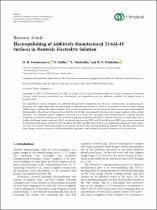 ResearchSpace
ResearchSpace
Electropolishing of additively manufactured Ti-6Al-4V surfaces in nontoxic electrolyte solution
JavaScript is disabled for your browser. Some features of this site may not work without it.
- ResearchSpace
- →
- Research Publications/Outputs
- →
- Journal Articles
- →
- View Item
| dc.contributor.author |
Tsoeunyane, GM

|
|
| dc.contributor.author |
Mathe, Ntombizodwa R

|
|
| dc.contributor.author |
Tshabalala, Lerato C

|
|
| dc.contributor.author |
Makhatha, ME

|
|
| dc.date.accessioned | 2022-08-22T08:24:39Z | |
| dc.date.available | 2022-08-22T08:24:39Z | |
| dc.date.issued | 2022-05 | |
| dc.identifier.citation | Tsoeunyane, G., Mathe, N.R., Tshabalala, L.C. & Makhatha, M. 2022. Electropolishing of additively manufactured Ti-6Al-4V surfaces in nontoxic electrolyte solution. <i>Advances in Materials Science and Engineering.</i> http://hdl.handle.net/10204/12480 | en_ZA |
| dc.identifier.issn | 1687-8434 | |
| dc.identifier.issn | 1687-8442 | |
| dc.identifier.uri | https://doi.org/10.1155/2022/6987353 | |
| dc.identifier.uri | http://hdl.handle.net/10204/12480 | |
| dc.description.abstract | The reduction of surface roughness on additively manufactured components has become a critical factor in engineering applications. This paper reports the electropolishing of additively manufactured Ti-6Al-4V by powder bed selective laser melting (SLM) using a nontoxic electrolyte solution. The results have shown that the salt-based electrolyte can be used to electropolish titanium alloys. The surface waviness of the as-built Ti-6Al-4V alloy was reduced by five times the average roughness of the as-built specimen. The minimum surface roughness obtained was 9.52 µm. The specimens were characterized by scanning electron microscope, Gwyddion software, and electrochemical impedance spectroscopy (EIS) to evaluate the surface morphology, surface profile, and charge transfer resistance. The X-ray photon spectroscopy (XPS) and X-ray diffraction (XRD) spectroscopy were used to characterize the surface chemistry of the specimen. The XPS and XRD showed TiO2 as the significant component on the surface of Ti-6Al-4V, and the atomic percentage on the surface increased after electropolishing. In addition, the EIS data indicated the high charge transfer resistance of the electropolished specimen, which shows the growth formation of the oxide layer. | en_US |
| dc.format | Fulltext | en_US |
| dc.language.iso | en | en_US |
| dc.relation.uri | https://www.hindawi.com/journals/amse/2022/6987353/ | en_US |
| dc.source | Advances in Materials Science and Engineering | en_US |
| dc.subject | Additive manufacturing | en_US |
| dc.subject | Ti-6Al-4V | en_US |
| dc.subject | Alloys | en_US |
| dc.title | Electropolishing of additively manufactured Ti-6Al-4V surfaces in nontoxic electrolyte solution | en_US |
| dc.type | Article | en_US |
| dc.description.pages | 12 | en_US |
| dc.description.note | Copyright © 2022 G. M. Tsoeunyane et al. This is an open access article distributed under the Creative Commons Attribution License, which permits unrestricted use, distribution, and reproduction in any medium, provided the original work is properly cited. | en_US |
| dc.description.cluster | Manufacturing | en_US |
| dc.description.impactarea | Laser Enabled Manufacturing | en_US |
| dc.identifier.apacitation | Tsoeunyane, G., Mathe, N. R., Tshabalala, L. C., & Makhatha, M. (2022). Electropolishing of additively manufactured Ti-6Al-4V surfaces in nontoxic electrolyte solution. <i>Advances in Materials Science and Engineering</i>, http://hdl.handle.net/10204/12480 | en_ZA |
| dc.identifier.chicagocitation | Tsoeunyane, GM, Ntombizodwa R Mathe, Lerato C Tshabalala, and ME Makhatha "Electropolishing of additively manufactured Ti-6Al-4V surfaces in nontoxic electrolyte solution." <i>Advances in Materials Science and Engineering</i> (2022) http://hdl.handle.net/10204/12480 | en_ZA |
| dc.identifier.vancouvercitation | Tsoeunyane G, Mathe NR, Tshabalala LC, Makhatha M. Electropolishing of additively manufactured Ti-6Al-4V surfaces in nontoxic electrolyte solution. Advances in Materials Science and Engineering. 2022; http://hdl.handle.net/10204/12480. | en_ZA |
| dc.identifier.ris | TY - Article AU - Tsoeunyane, GM AU - Mathe, Ntombizodwa R AU - Tshabalala, Lerato C AU - Makhatha, ME AB - The reduction of surface roughness on additively manufactured components has become a critical factor in engineering applications. This paper reports the electropolishing of additively manufactured Ti-6Al-4V by powder bed selective laser melting (SLM) using a nontoxic electrolyte solution. The results have shown that the salt-based electrolyte can be used to electropolish titanium alloys. The surface waviness of the as-built Ti-6Al-4V alloy was reduced by five times the average roughness of the as-built specimen. The minimum surface roughness obtained was 9.52 µm. The specimens were characterized by scanning electron microscope, Gwyddion software, and electrochemical impedance spectroscopy (EIS) to evaluate the surface morphology, surface profile, and charge transfer resistance. The X-ray photon spectroscopy (XPS) and X-ray diffraction (XRD) spectroscopy were used to characterize the surface chemistry of the specimen. The XPS and XRD showed TiO2 as the significant component on the surface of Ti-6Al-4V, and the atomic percentage on the surface increased after electropolishing. In addition, the EIS data indicated the high charge transfer resistance of the electropolished specimen, which shows the growth formation of the oxide layer. DA - 2022-05 DB - ResearchSpace DP - CSIR J1 - Advances in Materials Science and Engineering KW - Additive manufacturing KW - Ti-6Al-4V KW - Alloys LK - https://researchspace.csir.co.za PY - 2022 SM - 1687-8434 SM - 1687-8442 T1 - Electropolishing of additively manufactured Ti-6Al-4V surfaces in nontoxic electrolyte solution TI - Electropolishing of additively manufactured Ti-6Al-4V surfaces in nontoxic electrolyte solution UR - http://hdl.handle.net/10204/12480 ER - | en_ZA |
| dc.identifier.worklist | 25822 | en_US |





